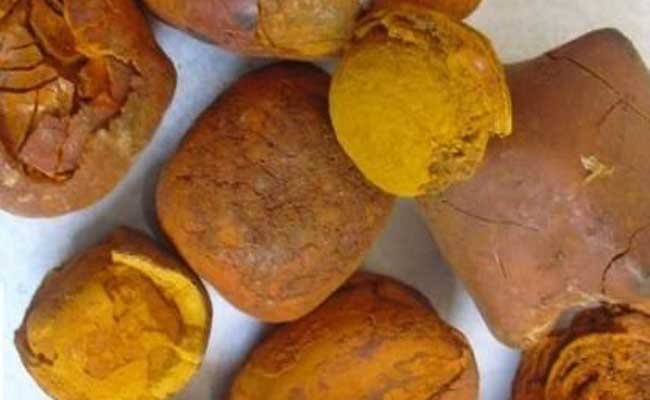Bezoar, as everyone knows, is actually a pathological product. However, when it occurs in the gall bladder bile of a cattle or ox, it becomes a rare, valuable Chinese herb called Niu Huang that is with a magical healing power of removing "toxins" from the human body. Medicinally ox gallstones were first recorded and viewed as a top-grade herb in Shen Nong Ben Cao Jing (the Divine Farmer's Materia Medica), an oldest text on medical herbs in China. And today it is still commonly used as an effective antidote for fever induced delirium, mania, convulsions in children, sore throat, Acne, mouth sores, Carbuncles, etc. Natural bezoar is so precious and rare that it is more expensive than gold. Hence, the less expensive substitute, artificial calculus bovis, is used more often and widely. But apparently there is considerable difference on efficacy between them.
In Chinese herbology, it refers to the dried cow gallstone of Bos taurus domesticus Gmelin or Bubalusbubalis Linnaeus, which is an animal in the family Bovidae. So, other name of it include Cattle Gallstone, cow gallstone, ox gallstone, Ox bezoars, cow bezoars, Bezoar from an ox, and so on. In China it is mainly produced in Beijing, Tianjin, Inner Mongolia, Shaanxi, Xinjiang, Qinghai, Hebei, and Heilongjiang. It is usually harvested when cattle is slaughtered. In this process if a mass found trapped in gallbladder, bile duct or common hepatic duct, it needs to filter out the bile, take the stone, remove the outer thin membrane, dry in the shade, and then grind into fine powder. Based on different locations, bezoar has 3 main varieties – Dan Huang (gallbladder bezoar), Guan Huang (bile duct bezoar), and Gan Huang (hepatic duct bezoar). And gallstones are generally believed with a better efficacy.
Natural bezoar stones are mostly ovoid, spherical, triangular or square, in various sizes, and 0.6 to 4.5cm in diameter. And a small number of them are tubular or fragmented. Surface is from yellowish red to brown orange; some are covered with a layer of black shiny thin film commonly known as "black gold clothing"; some are rough and warty; some have craquelure. It is lightweight, crisp, and easy to be layered and peeled off. Golden cross section sees finely concentric lamellae and some are with white core in the middle. It is faintly scented, bitter sweet, cool and refreshing, and fragile and non-sticky when being chewed.
BEZOAR HEALTH BENEFITS
As a well-known herbal supplement, bezoar has always been revered in traditional Chinese medicine. It is said that its healing property was unintentionally discovered by Bian Que, a highly-skilled doctor in ancient China. Since then it has been used medicinally for more than 2000 years. Today it still works like a charm in the treatment of various diseases like encephalitis and hemorrhagic fever. When it comes to emergency treatments, Chinese medicine is probably the last one to be thought of. In fact, TCM has 3 first-aid secret weapons – An Gong Niu Huang Wan (AGNH), Zi Xue Dan, and Zhi Bao Dan. And statistically there are more than 200 kinds of bezoar-based Chinese patent drugs currently, such as Niu Huang Shang Qing Wan, Niu Huang Qing Xin Wan, Qian Jin San, Liu Shen Wan, and so on.

Bezoar
SAMPLE CALCULUS BOVIS HERBAL REMEDIES
The Chinese Pharmacopoeia believes that bezoar is sweet in flavor and cool in nature and it covers meridians of heart and liver. Basic functions are clearing away the heart-fire, eliminating phlegm, inducing resuscitation, cool the liver, dispelling wind, and relieve internal heat or fever. Main bezoar uses and indications include fever-induced coma, stroke, epilepsy seizures, cramp, mania, sore throat, mouth sores, and boils. Recommended dosage is from 0.15 to 0.35g in pills or powder.
1. An Gong Niu Huang Wan from Wen Bing Tiao Bian (Detailed Analysis of Warm Diseases). It is combined with She Xiang (musk), Bing Pian (borneol), Zhu Sha (cinnabar), Huang Lian (Coptis Root), Zhi Zi (Gardenia), etc. to treat the invasion of pericardium by heat, stroke, convulsions, and epilepsy, in which the blocked heart orifice induces coma, delirium, fever, irritability, trismus, difficulty moving tongue, choking because of phlegm in throat, etc.
2. Niu Huang San from Zheng Zhi Zhun Sheng (The Level-line of Patterns & Treatment). It is formulated with cinnabar, Quan Xie (Scorpion), Gou Teng (Cat's Claw), etc. to cure acute infantile convulsions, in which main symptoms include high fever, coma, convulsions, and so on.
3. Niu Huang Jie Du Pian or Wan from Quan Guo Zhong Cheng Yao Chu Fang Ji (National Collection of Chinese Herbal Prepared Medicines). It is matched with Huang Qin (Scutellaria Baicalensis), Xiong Huang (realgar), Da Huang (Rheum Palmatum), etc. to heal stagnated fire toxin induced mouth and tongue sore, sore throat, and toothache.

![Diseases, Symptoms, tcm, [tcmwindow.com]](/uploadFile/adImg/2015/11/11/f5cbfcc0-4df5-4646-9b9a-f316651a0199.jpg)





